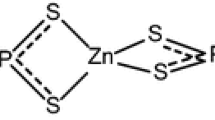Abstract
A hybrid lubricant film was prepared from the perfluoropolyether (PFPE) lubricant (Moresco DDOH), with a single end group, and a PFPE film obtained by depositing the HT170 film via photoelectron-assisted chemical vapor deposition (PACVD). The frictional properties of the prepared film were evaluated using a pin-on-disk tester and compared with those of a Z-tetraol dip-coated film. This hybrid lubricant film showed a considerably high bonding ratio of ~ 100% after Vertrel rinsing and lower surface energy than those of Z-tetraol. The frictional coefficient of only the PACVD-treated HT170 film was considerably high. However, the hybrid lubricant film without the mobile fraction showed a friction coefficient equivalent to that of the Z-tetraol film having a mobile fraction of 40%.












Similar content being viewed by others
References
Chen C-Y, Bogy D, Bhatia CS (2001) Effect of lubricant bonding fraction at the head–disk interface. Tribol Lett 10:195–201
Karis TE, Tyndall GW, Waltman RJ (2001) Lubricant bonding effects on thin film disk tribology. Tribol Trans 44:249–255
Kiely JD, Jones PM, Yang Y, Brand JL, Anaya-Dufresne M, Fletcher PC, Zavaliche F, Toivola Y, Duda JC, Johnson MT (2017) Write-induced head contamination in heat-assisted magnetic recording. IEEE Trans Magn 53:3300307
Sakane Y, Wakabayashi A, Li L, Kasai PH (2006) Effect of molecular structure of PFPE lubricant on interaction at HDI in near-contact operation. IEEE Trans Magn 42:2501–2503
Shimizu Y, Umehara N, Xu J (2010) Fluorine-ion-implanted air-bearing surface for low-friction head–disk interface. Microsyst Technol 16:293–299
Tani H, Lu R, Koganezawa S, Tagawa N (2017) Ultrathin PFPE/DLC hybrid overcoat for magnetic disks by photoelectron-assisted chemical vapor deposition. IEEE Trans Magn 53:3300906
Tani H, Uesaraie Y, Lu R, Koganezawa S, Tagawa N (2018) Smear growth on head slider surface from siloxane outgas on heat assisted magnetic recording. Microsyst Technol 26:4641–4648
Zhao Z, Bhushan B (1996) Effect of bonded lubricant films on the tribological performance of magnetic thin-film rigid disk. Wear 202:50–59
Acknowledgement
This work was financially supported by KAKENHI Grant No. 17K06131 from the Ministry of Education, Culture, Sports, Science and Technology (MEXT) and Kansai University’s grant to Research Group on Tribotronics of ORDIST.
Author information
Authors and Affiliations
Corresponding author
Additional information
Publisher's Note
Springer Nature remains neutral with regard to jurisdictional claims in published maps and institutional affiliations.
Rights and permissions
About this article
Cite this article
Tani, H., Uesaraie, Y., Lu, R. et al. Hybrid lubricant film with high bonding ratio and high coverage. Microsyst Technol 26, 3331–3337 (2020). https://doi.org/10.1007/s00542-020-04806-9
Received:
Accepted:
Published:
Issue Date:
DOI: https://doi.org/10.1007/s00542-020-04806-9




